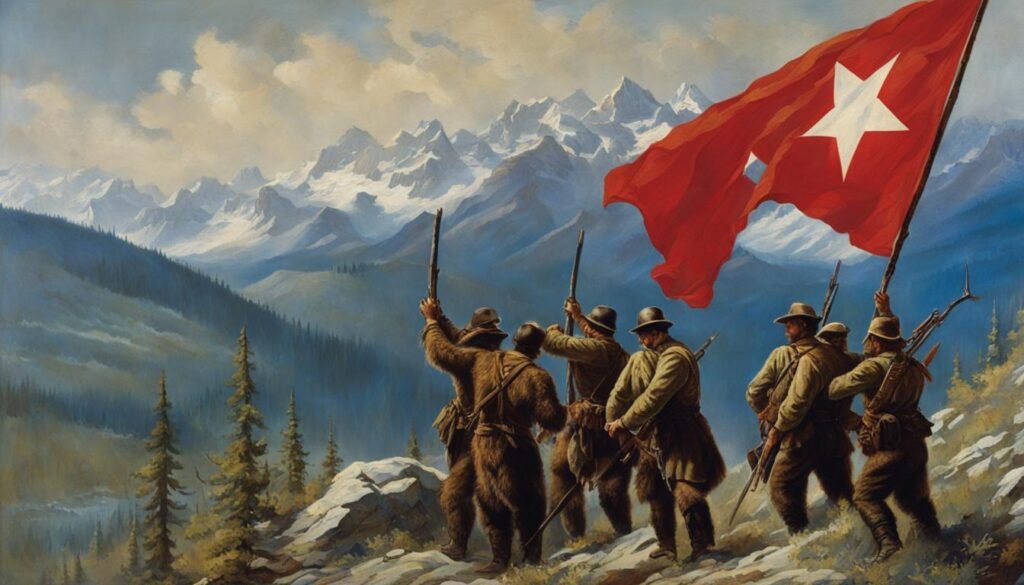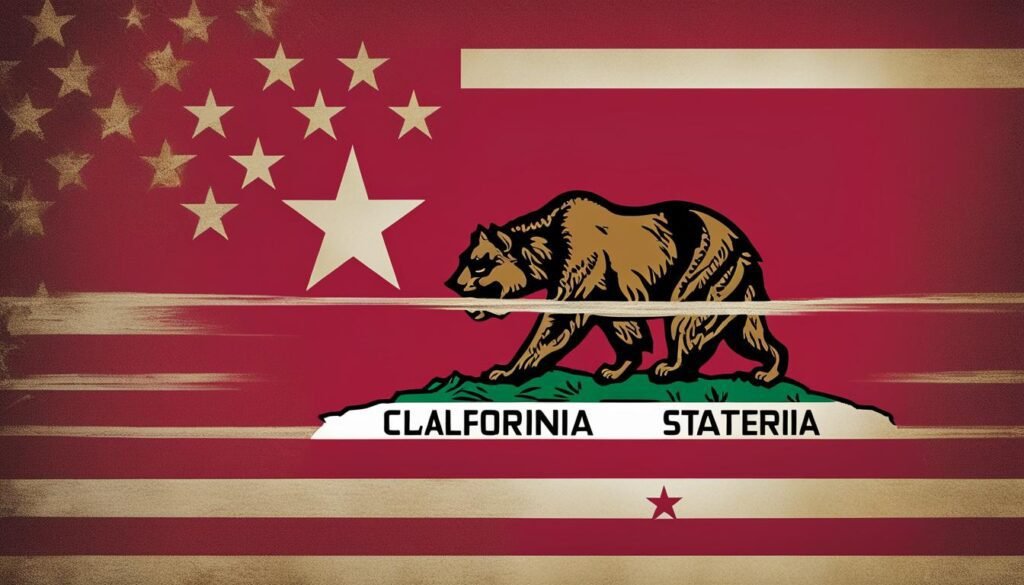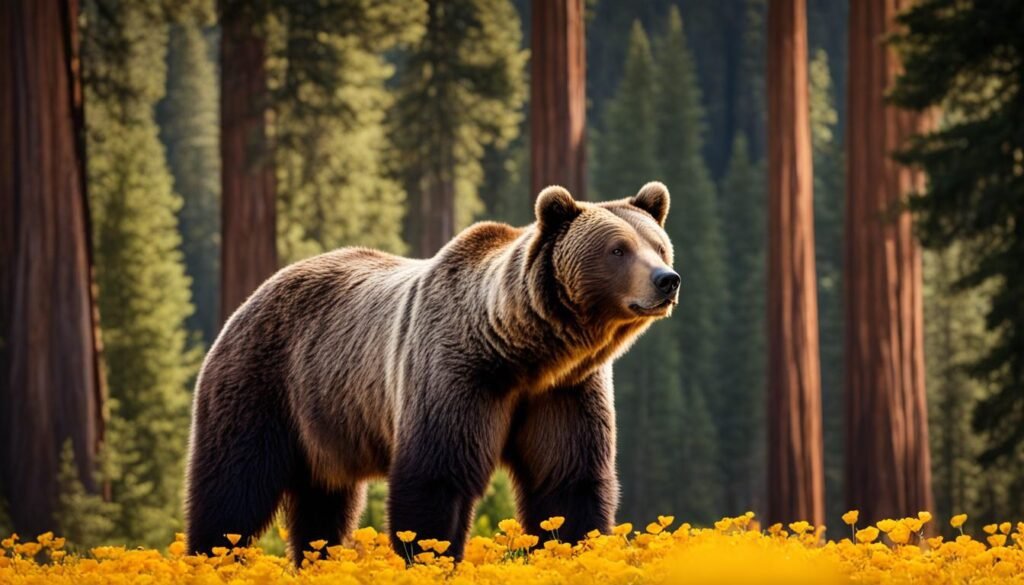Hello there! Today, I want to take you on a journey to uncover the fascinating history and meaning behind the beloved flag of California. As an emblem synonymous with the state’s identity, the flag of California holds both symbolic and historical significance. So, let’s dive into the story behind this iconic emblem and explore the hidden tales it unveils.
When we think of California, one of the first images that come to mind is its distinct flag. The state flag of California, also known as the Bear Flag, proudly displays a vivid red star and stripe borrowed from the American flag. And of course, who could forget the imposing grizzly bear standing tall at the center, a symbol of the state’s strength and resilience.
Key Takeaways:
- The California flag is also referred to as the Bear Flag.
- It features a red star and stripe from the American flag.
- The grizzly bear symbolizes the strength of California.
- The flag has a rich history and dates back to the Bear Flag Revolt in 1846.
- The bear featured on the flag is known as Monarch.
The Birth of the Bear Flag
The Bear Flag, which is the precursor to the current state flag of California, was born during the Bear Flag Revolt in 1846. American settlers in Mexican-controlled Northern California declared California as an independent republic. The original flag featured a red stripe, a star, and a crude drawing of a bear. Its design was inspired by the Texan Lone Star flag. The revolt lasted less than a month before California became part of the United States, but the bear symbol on the flag remained and evolved over time.


The Bear Flag Revolt in 1846 marked a significant moment in California’s history. American settlers, dissatisfied with Mexican rule, seized control of the Sonoma region and declared California as an independent republic. This rebellion led to the creation of the Bear Flag, a symbol of their newfound independence and unity.
The original Bear Flag design, often referred to as the “Bear Flag of Sonoma,” was simple and crude. It featured a red stripe running vertically down the flag, a five-pointed star in the upper left corner, and a rudimentary drawing of a grizzly bear in the center. The bear, although not artistically refined, symbolized the strength and resilience of the settlers.
The Bear Flag’s design was directly influenced by the Texan Lone Star flag, which was also a symbol of independence and rebellion. The lone star represented Texas’ struggle for independence from Mexico, a shared history that resonated with the California settlers.
The Bear Flag Revolt itself was short-lived and lasted less than a month. On July 9, 1846, the American flag was raised over Sonoma, marking the end of the independent California Republic. California soon entered into the Mexican-American War and became part of the United States in 1848 under the Treaty of Guadalupe Hidalgo.
Despite the revolt’s brevity, the bear symbol on the flag endured. Over time, artists and designers refined the bear’s appearance, turning it into the iconic image seen on the current state flag of California. The bear’s posture changed, becoming more upright and regal, while the details of its fur and features became more intricate.
Evolution of the Flag
After the Bear Flag Revolt, the design of the California flag underwent several changes. For over 50 years, California did not have an official state flag. In 1911, the California Legislature passed a bill to establish a basic design for the state flag, introducing the iconic elements we recognize today. This included a red star and stripe, a depiction of a grizzly bear, and the words “California Republic.” However, no specific design was specified, leading to various versions of the flag being flown.


It wasn’t until later legislation that the current standardized design became the official state flag. The flag’s colors are red, white, and green, symbolizing courage, purity, and hope, respectively. The adoption of a standardized design ensured consistency and recognition of the California flag across the state.
Symbolism and Meaning
The California flag holds profound symbolism and carries significant meaning. Each element on the flag represents a unique aspect of the state’s identity and history.
The red stripe, star, and the bear’s tongue symbolize courage – a testament to the resilience and bravery of the people of California.
The white field represents purity, highlighting the state’s commitment to principles of honesty and integrity.
The green color under the bear’s feet draws inspiration from the flag of Mexico and signifies hope and victory. It serves as a reminder of the state’s multicultural heritage and triumph over challenges.
The lone star in the canton of the flag recalls the Texas Lone Star flag. Both California and Texas shared a common history as they gained independence from Mexico and briefly became independent republics. The star represents the state’s spirit and independence.
The grizzly bear depicted on the flag symbolizes California’s strength and sovereignty. It is a tribute to the once-abundant grizzly bear population in the state and a reflection of the state’s power.
The California flag is not merely a piece of cloth; it is a visual representation of the state’s history, values, and identity.
Legacy and Controversy
The official California flag, with its rich history and symbolism, has a mixed legacy and has faced some controversy. Since becoming the official state flag in 1911, it has been widely recognized and used as a symbol of California.
Differing Opinions and Historical Figures
There are differing opinions among historians and scholars regarding the historical figures associated with the Bear Flag Revolt and the actions they took. Some view them as celebrated rebels who fought for independence, while others criticize their behavior, including acts of violence and mistreatment of indigenous people.
A Recognizable and Important Symbol
Despite the controversies surrounding its origins, the California flag remains a recognizable and important symbol of the state. It represents the history, identity, and values of the people of California.
California Flag Facts
- The California flag became the official state flag in 1911.
- It features a red star and stripe taken from the U.S. flag, a grizzly bear as a symbol of the state’s strength, and the words “California Republic”.
- The bear on the flag is known as Monarch, and its design draws inspiration from the Lone Star flag of Texas.
- For over 50 years, California did not have an official state flag. The current design became official through later legislation.
- The flag’s colors are red, white, and green, symbolizing courage, purity, and hope respectively.
Despite its controversial origins, the California flag continues to hold a significant place in the hearts of Californians and serves as a reminder of the state’s past and its enduring spirit.
Conclusion
The flag of California carries a powerful historical narrative, reflecting the spirit of rebellion, independence, and the state’s rich heritage. Throughout its evolution, the flag has retained its key elements – the bear symbol, the red star, and stripe. These enduring features serve as a proud symbol of California’s identity and values.
With deep symbolism, the California flag represents courage, purity, and hope. Each element holds significance, from the red stripe embodying courage, to the white field signifying purity, and the green color symbolizing hope and victory. The lone star in the canton, reminiscent of the Texas Lone Star flag, pays tribute to California’s brief period of independence from Mexico alongside Texas.
The California flag’s profound meaning stems from its historical context, particularly the Bear Flag Revolt. The flag stands as a testament to the state’s strength and sovereignty, harking back to the rebellion that led to California’s assertion of independence and subsequent joining of the United States. Despite its controversial origins, the flag remains a cherished symbol of California’s heritage and values.
In conclusion, the flag of California captures the essence of the state’s narrative, epitomizing its rebellious spirit, rich history, and enduring legacy. As it flies proudly across the Golden State, the California flag serves as a visual reminder of the struggles and triumphs that have defined the region. It represents not only the past but also the present and future, embodying the collective experiences, aspirations, and unity of the diverse people who call California home.
FAQ
What does the flag of California look like?
The flag of California features a red star and stripe taken from the U.S. flag, a grizzly bear as a symbol of the state’s strength, and the words “California Republic.” It has a white field and a green bottom stripe.
Why is there a bear on the California flag?
The bear on the California flag represents the state’s strength and sovereignty. It is known as Monarch and symbolizes the wildlife and natural resources found in California.
What is the history behind the California flag?
The flag originated from the Bear Flag Revolt in 1846 when American settlers declared California as an independent republic. The design of the flag has evolved over time, but the bear symbol and the red star and stripe have remained constant.
What do the colors on the California flag represent?
The red stripe, star, and the bear’s tongue symbolize courage, while the white field represents purity. The green color under the bear’s feet represents hope and victory.
Is there any controversy surrounding the California flag?
Yes, there are differing opinions about the historical figures associated with the Bear Flag Revolt and their actions. Some view them as celebrated rebels, while others criticize their behavior, including acts of violence and mistreatment of indigenous people.
Why is the California flag important?
The California flag is important as it represents the state’s identity, history, and values. It serves as a symbol of rebellion, independence, and California’s rich heritage.









